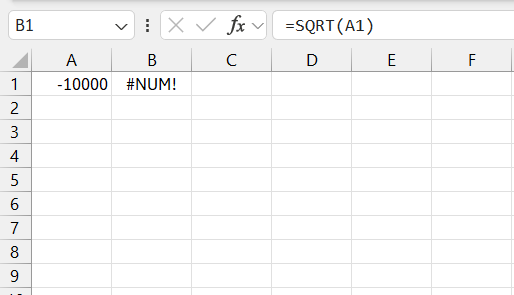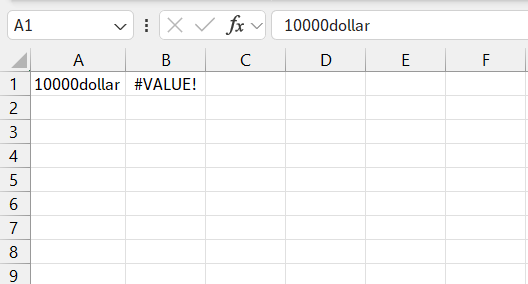

Microsoft Excel makes calculating square roots straightforward with the SQRT function, a tool essential for anyone working with numerical data. This skill is crucial across various fields, from engineering to finance, for analyzing data and understanding numerical relationships.
Key Takeaways
- SQRT Function: SQRT function efficiently calculates the square root in Excel of a given number, vital for precise data analysis and decision-making.
- Formula Syntax: The syntax for SQRT is simple: =SQRT(number), where “number” is the value or cell reference for the square root calculation.
- Practical Applications: Square root calculations play a significant role in finance, engineering, statistics, and education, enabling professionals to perform complex analyses directly in Excel.
- Accuracy Tips: To ensure precise calculations, use cell references, validate inputs, and combine SQRT with other functions as needed, leveraging Excel’s auditing tools for accuracy.
- Handling Inputs: Ensure inputs are positive and numerical to avoid errors, and use Excel’s POWER function for more complex root calculations or when needing to calculate cube roots or other nth roots.
Table of Contents
Introduction to Excel’s Square Root Calculations
Unveiling the SQRT Function
In the realm of Excel, delving into the mathematics of square root calculations is quite a stroll in the digital park. The SQRT function, a boon for number crunchers, springs into action when one needs to square that circle—or square root that number, to be precise. It’s singular in its purpose: hand it a number, and it’ll give you the square root with the efficiency of a well-oiled machine.
Why Mastering Square Roots in Excel Matters
Mastering square roots in Excel is an intellectual asset for anyone who tangles regularly with numbers. Whether you’re an engineer calculating resistances, a statistician analyzing data distributions, or a financial analyst assessing investment risks, understanding how to compute square roots using Excel is a versatile skill.
Calculating square roots in Excel not only amplifies your mathematical agility but also fosters data-driven insights. It equips you to perceive relationships within datasets that might be invisible to the naked eye, tapping into trends and variances like never before.
The Mechanics of the SQRT Function
Formula Breakdown and Syntax
The SQRT function in Excel is quite straightforward. Here’s how it breaks down:
- Function Name: SQRT
- Purpose: To calculate the square root of a given number.
- Syntax: =SQRT(number)
In the syntax, “number” represents the numeric value or cell reference you want to find the square root of. You’d simply replace “number” with the actual number or the cell containing your value – and voilà, Excel does the rest.
Remember, Excel functions are sensitive to opening and closing parentheses, so ensure you complete the function with a closing parenthesis to avoid errors.
Keep this syntax in mind as it is the passport to unlocking a trove of calculations that the SQRT function allows you to perform efficiently.
Step-by-Step Guide to Calculate Square Root in Excel
Diving into Excel’s SQRT function, let’s walk step-by-step through how you would use it in your everyday tasks:
STEP 1: Select Your Cell: Click on the cell where you want the square root result to appear. This will be your output cell.
STEP 2: Initiate the Function: Type the equals sign = followed by the function name SQRT( into the selected cell.
STEP 3: Input Your Number (or Cell Reference): After SQRT(, input the number you wish to find the square root of, or the cell reference containing the number.
STEP 4: Complete the Function: Close the parentheses ) after your number or reference.
STEP 5: Execute the Function: Hit Enter, and the square root of the number should display in the selected cell.
Here’s an example: if you want to calculate the square root of 16, you would type =SQRT(16) into a cell and press Enter. The cell would then display the number 4, which is the square root of 16.
Practical Applications of SQRT in Excel
Real-life Scenarios for Square Root Calculations
Square root calculations are essential across various real-life scenarios:
- Financial Analysis: In finance, the square root is used to calculate the volatility of stock returns, known as the standard deviation. This helps investors understand the risk associated with different financial instruments.
- Engineering Problems: Engineers use square roots in various calculations, such as determining the root mean square value which is crucial for assessing the magnitude of oscillating variables like electrical currents.
- Statistics and Data Analysis: Statisticians calculate the square root when working with the standard deviation and variance to evaluate data spread and consistency.
- Physics and Sciences: In physics, square roots help calculate forces, speeds, and energies. For example, using Newton’s second law, one might calculate the force required to move an object by taking the square root of the product of its mass and acceleration.
- Education and Academics: Students and teachers often apply the square root function in problem-solving across STEM subjects, enhancing learning experiences and academic research.
By familiarizing themselves with the SQRT function, professionals in these fields can tackle complex calculations directly within their spreadsheets, streamlining their workflow and enabling more accurate analyses.
Tips for Accurate and Efficient Results
Ensuring accuracy and efficiency with the SQRT function requires a blend of caution and Excel savvy. Here are some tips to keep in mind:
- Avoid Manual Entry When Possible: Instead of manually entering numbers, use cell references in your SQRT formula. This prevents human error and updates results automatically if input values change.
- Double-Check Your Inputs: Always cross-verify the numbers you’re taking the square root of, especially if they’re critical figures in your analysis or reporting.
- Use Named Ranges: For better readability and easier formula auditing, define named ranges in your spreadsheet for cells that you frequently reference.
- Leverage Excel’s Auditing Tools: Utilize tools like Trace Precedents and Trace Dependents to ensure your square root calculations are based on the correct inputs and are not influencing other parts of your spreadsheet erroneously.
- Combine with Other Functions: Sometimes, you may need to nest the SQRT function within other formulas. Make sure the overall formula makes logical sense and that each nested function is correctly configured.
By applying these tips, you ensure that your square root calculations in Excel are both accurate and efficient, making your data analysis or problem-solving process smoother and more reliable.
Ensuring Valid Inputs for Successful Calculations
To ensure successful calculations with the SQRT function in Excel, verifying that inputs are valid is a step you can’t afford to skip. Here’s how to guarantee the validity of your inputs:
- Confirm Number Positivity: Since square roots of negative numbers don’t exist within real numbers, confirm that your inputs are zero or positive to avoid the #NUM! error.
- Validate Data Types: Ensure the cell or value you are passing to the SQRT function is purely numerical. Any text or non-numerical strings will trigger the #VALUE! error.
- Check for Data Consistency: When pulling data from different sources or sheets, ensure consistency in format and type to prevent input errors.
These simple checks will go a long way in maintaining the precision of your square root calculations, allowing you to trust the results that Excel delivers.
FAQs
Can SQRT Handle Negative Numbers?
No, the Excel SQRT function cannot handle negative numbers as it’s designed to return the square root of a positive number only. If you input a negative number, it will result in a #NUM! error because a negative number doesn’t have a real-number square root in standard mathematics.
To work around this, combine the SQRT function with the ABS function: =SQRT(ABS(number)). This effectively treats negative inputs as positive values and calculates the square root accordingly.
What Is the Difference Between SQRT and the POWER Function for Square Roots?
The SQRT function is a specialized tool designed explicitly for calculating the square root of a number—no more, no less. In contrast, the POWER function is the Swiss Army knife of exponents, capable of raising any number to any power, including fractional exponents which can represent roots.
Use SQRT when you solely need to find a square root as it’s simpler and direct: =SQRT(number). Choose POWER when working with various exponents or when you need to find different roots, such as cube roots: =POWER(number, 1/3) for a cube root, or =POWER(number, 1/n) for an nth root.
The POWER function provides flexibility, and for square roots, you can use =POWER(number, 0.5) as an alternative to SQRT.
How Can I Calculate Multiple Square Roots Simultaneously?
To calculate multiple square roots simultaneously in Excel, use an array formula. Here’s what to do:
- Select the range of cells where you want the results.
- Type
=SQRT(followed by the range of numbers you need square roots for, likeA1:A5. - Press
Ctrl+Shift+Enterinstead of just Enter. This confirms it as an array formula, and Excel processes it for the entire range at once.
For non-contiguous cells, use a formula like =SQRT((A1, B1, C1)) making sure to press Ctrl + Shift + Enter. This technique is a real time-saver when dealing with extensive datasets.
What is the square root formula in Excel?
The square root formula in Excel is encapsulated by the SQRT function. Simply put, you use =SQRT(number) where “number” is the value you want to calculate the square root for. Type this formula into a cell and replace “number” with the actual number or a cell reference that contains the number to get the square root.
When the formula gets executed, Excel calculates and displays the square root of the specified number in the cell where you entered the formula.
How do you find the cube root in excel?
To find the cube root in Excel, you can use the POWER function with the exponent set to one third. The formula looks like this: =POWER(number, 1/3).
Just replace “number” with the numerical value or the reference to the cell containing the value you want to find the cube root of. When you press Enter, Excel gives you the cube root of the specified number.


John Michaloudis is a former accountant and finance analyst at General Electric, a Microsoft MVP since 2020, an Amazon #1 bestselling author of 4 Microsoft Excel books and teacher of Microsoft Excel & Office over at his flagship MyExcelOnline Academy Online Course.














